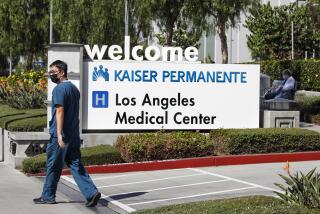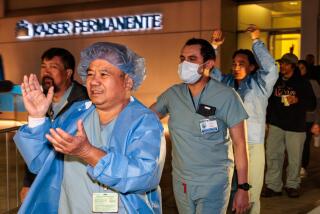Product Mix Has Changed but Link to Past Still Magic : Rial Will Keep Kaiser Steel Name
- Share via
Kaiser Steel is a misnomer: It doesn’t make steel, and the Kaiser corporate empire broke up years ago. But new management of the Fontana company is keeping the venerable name nonetheless.
Monty H. Rial, who became chairman and chief executive last week, said that Kaiser Steel “has been so vitally involved” in the businesses the company still operates that “it would be very hard to change the name.”
For the record:
12:00 a.m. May 24, 1985 FOR THE RECORD
Los Angeles Times Friday May 24, 1985 Home Edition Business Part 4 Page 2 Column 4 Financial Desk 2 inches; 70 words Type of Material: Correction
Kaiser Steel currently has assets of about $838 million, down from $991 million in March, 1984, while its net worth was $135 million at the end of the first quarter, up from $50 million the year before. The Times reported incorrectly May 11 that net worth now exceeds year-ago assets. The article also said that Kaiser Steel’s debt had been paid down by $200 million. Kaiser Steel now says that, although it has cut liabilities by more than $200 million, the debt portion has been refinanced but not reduced.
Its giant Fontana steel mill is gone--now operated by a Long Beach businessman and his Brazilian and Japanese partners--and but a thin thread still links the company to the Kaiser family since its February, 1983, acquisition by two investment groups.
In addition to the name, Rial said he intends to retain the spirit imbued in Kaiser Steel by its founder, industrialist Henry J. Kaiser, who had “tremendous vision and was a very bold individual. He was a great builder, a great constructor of things.
“While we must, at this stage in our renaissance, be more conservative--financially conservative--than he was, we would like to think we share very many of the fundamental values . . . he left this business.”
As traditional as the name and spirit may be, the company’s coal and real estate assets are the greater legacy. Even with them, however, Rial faces a formidable task in reviving Kaiser Steel.
Prices for its main products--coal and fabricated steel items such as pipe and oil drilling rigs--continue to be depressed. It has substantial debts, many stemming from the refinancing of the loan that provided the backing for the buy-out of Kaiser Steel’s public shareholders.
And Rial, 43, now finds himself alone at the helm of a company significantly larger than his former company, Perma Resources, including managing more than four times the amount of coal reserves.
But the first hurdle, strangely enough, may be public image. “The thing that’s been the hardest for us to counter,” Rial said, is that “when you close a basic core business like the steel mill, the rest of the world thinks of you as being a dormant enterprise. And we are not that.”
The Fontana Works steel mill, the centerpiece around which all other Kaiser Steel companies were laid, had become a costly millstone to the company, and its phased shutdown--Rial called it a “most prudent decision”--was completed in December, 1983.
The company’s coal mining operations and its fabricated products division were the real lures for the company’s many suitors, who included Minneapolis financier Irwin L. Jacobs.
Two investment groups--Perma Group, headed by Rial, and another led by J. A. Frates of Tulsa, Okla.--went 50-50 on the winning $374.4-million bid. As part of the deal, Perma Resources, the Colorado Springs, Colo.-based energy concern of which Rial was a founder and president, was to fold into Kaiser its primary coal mine, and Perma Group eventually would take total control of Kaiser Steel.
Last month, Perma Group bought out its partners for $40 million in properties and cash and Joe Frates bowed out as chairman.
Rial, who had run Kaiser Steel’s day-to-day operations as its vice chairman during the year of co-ownership, was named chairman and chief executive May 2. Remaining on the board is Stephen Girard, a longtime Kaiser family associate who became chairman, president and chief executive of Kaiser Steel after the liquidation of Kaiser Industries.
Including the steel mill, some real estate and its steel drum business, Kaiser Steel has shed about $250 million in assets in the 14 months since the Perma and Frates groups took over.
But, Rial said, the addition of the Perma Resources mine in Utah, investments and two acquisitions have raised Kaiser’s net worth to above the year-ago starting point of $900 million in assets.
He also said the company had paid down its debt by $200 million.
“We are not in the process of reducing Kaiser Steel in a material way. . . . Our overall conduct from the time we acquired the company until now has been strengthening of the business,” he said.
Because of the reshuffling of Kaiser Steel in the past year, it is difficult to judge the company’s financial status.
In the first quarter of 1985, the company had a $1.8-million loss, primarily due to losses in its fabricated products division. The loss compared to earnings of $351,000 in the 1983 first quarter.
But last year’s figures reflect discontinuance of the steel operations and other changes during the ownership switch; this year’s report also includes one-time gains.
For all of last year, Kaiser had net income of $47.7 million, contrasted with a loss of $422.8 million in 1983.
The 1984 profit was attributable mainly to substantial reductions in the reserves for its discontinued steelmaking operations, the company said.
But Rial is confident that the strides being made in the company’s operations will pick up the slack once the rejuggling is over. He said the company is now producing and selling coal at the highest level in its history: The company predicts that it will ship somewhat less than 4 million tons of coal in 1985. In 1984, shipments totaled 2.2 million tons--double the 1.1 million tons shipped in 1983.
The bulk of the coal is contained in sites that were Kaiser Steel’s before the ownership change. To Kaiser’s 900 million tons of coal reserves, the Perma Resources property added between 250 million and 300 million tons of recoverable coal; an additional 100 million or so tons were added to Kaiser Steel reserves when the company purchased two properties adjacent to Kaiser’s Utah mine, one from U.S. Steel and the other from Standard Oil of Ohio.
Profitable Coal Operations
Despite the West’s “worst market conditions and competition” ever for coal, “we have taken Kaiser coal operations to an all-time high,” Rial said.
The profitable coal operations account for about half of Kaiser Steel’s business; the fabricated products division is the next most consequential, contributing almost a third, Rial said.
About an eighth of the company consists of real estate and water resources in Southern California, and a smattering of other businesses account for the remainder.
The fabricated products division, Rial said, “is close to break-even,” and he predicted that, by year-end, it too would post a profit. He cited the orders for 40,000 tons of large-diameter pipe in the first quarter of 1985; by contrast, in all of 1984, the company shipped 28,000 tons of such pipe.
Rial said the Kaiser Steel name long has been associated with pipe making. But other of the fabricated products are better known, perhaps, to the public; the steel superstructures of the readily recognizable Transamerica Pyramid in San Francisco and its towering neighbor, the Bank of America World Headquarters building, were fabricated and erected by Kaiser Steel, as were those for the twin Arco Towers, the Wells Fargo Building and Security Pacific Plaza in downtown Los Angeles. The space shuttle Columbia’s giant traveling hangar was made by Kaiser Steel.
But the steel no longer is made in the huge ovens of the nearby steel mill. Whereas at its peak in the late 1970s the company employed as many as 13,000 workers--8,000 of them sweating in the cavernous plant--Kaiser Steel now has roughly 2,000 employees.
Kaiser Steel companies still buy some of the steel produced by its former plant at Fontana, but the synergy between the companies is a mere shadow of the days when the coal, iron ore, limestone and water from Kaiser’s vast resources supplied the mill, and the steel was hammered into drums at its now-sold Myers Drum unit or into tubing and pipes that carried the oil drilled on Kaiser-made oil rigs.
In those long-ago days, Kaiser steel was sold to other companies in the Kaiser Industries family; steel for the World War II ships, or to reinforce the bridges and dams that were designed by Kaiser engineers and built with Kaiser cement.
Rial does not take the Kaiser tradition lightly. He said Kaiser Steel is commited to its employees and the community of Fontana, the town about 45 miles east of Los Angeles that grew up around the mill. And Perma Group, he said, is sticking with Kaiser.
“We are not financiers buying and selling businesses. We have been in the coal business a long, long time. Our basic underlying theme is commitment . . . to focus on the businesses that we believe we can do an excellent job with. We don’t move in and out because of fluctuations in the marketplace.”
More to Read
Inside the business of entertainment
The Wide Shot brings you news, analysis and insights on everything from streaming wars to production — and what it all means for the future.
You may occasionally receive promotional content from the Los Angeles Times.










